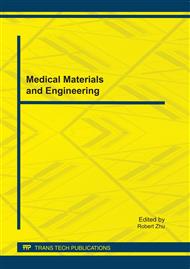p.137
p.142
p.152
p.157
p.162
p.167
p.172
p.178
p.183
Influence of Impeller Design on Hemolysis of an Axial Blood Pump
Abstract:
Compared to centrifugal blood pumps, the high rotating speed of axial blood pumps lead to blood damage more easily. In order to improve blood compatibility of the axial blood pump developed by the authors, traditional method and three-dimensional streamlined method are used for axial impeller design, and rapid prototyping with ABS organic materials are adopted. Finally, hydraulic experiments and hemolysis tests have been conducted. The results reveal that the impeller design and the design parameters (diameter and length) affect the hydraulic performance and hemolysis of the axial pump obviously. The hemolysis index in axial flow impeller pump using traditional method is 0.12, while the minimum value of hemolysis index in the streamlined axial blood pump is 0.06, below the permitted hemolysis value of 0.1.
Info:
Periodical:
Pages:
162-166
Citation:
Online since:
November 2011
Authors:
Keywords:
Price:
Сopyright:
© 2012 Trans Tech Publications Ltd. All Rights Reserved
Share:
Citation:


